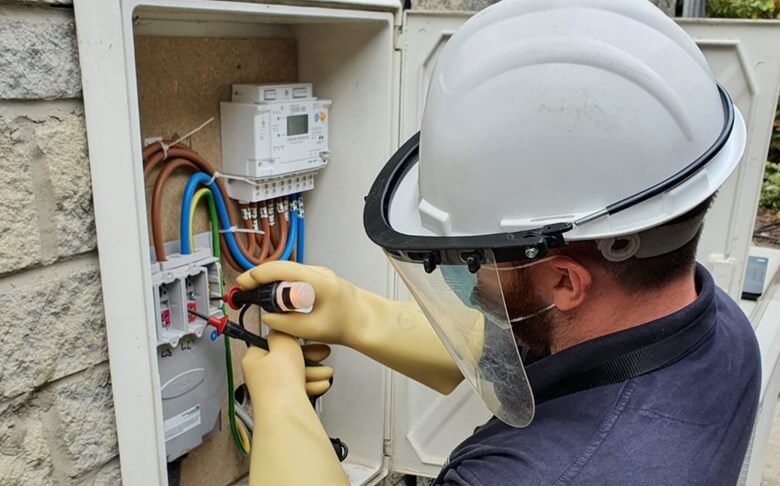Why do businesses need half-hourly meters?

What is half-hourly metering?
A half-hourly meter is an advanced metering system that uses Automatic Meter Readings (AMR) technology to provide a more accurate energy reading. Unlike traditional meters that require readings to be sent manually, half-hourly meters automatically send an energy reading every half hour to the energy supplier, therefore offering greater convenience for businesses. This granular data is essential for business energy monitoring as it offers deeper insights into energy use patterns.
To process half-hourly readings, businesses will need a Data Collector (DC) as well as a Meter Operator (MOP) Agreement for maintenance. At SMS, we are experts in the installation and operation of electricity meters for UK industrial, commercial, and public sector organisations. We are Meter Operator (MOP) for non-half-hourly (NHH) and half-hourly (HH) meter supplies, and one of the leading independent electricity metering service providers for UK businesses. Discover our half-hourly metering solutions.
Does my business need a half-hourly meter?
Whether your business needs a half-hourly meter depends on the size of your energy consumption and specific legal requirements.
As of 1st April 2017, in line with Ofgem’s market-wide reform (P272), all businesses in profile classes 5 to 8 are mandated to record energy use every half hour. That means, if the S number on your Meter Point Administration Number (MPAN) is 05, 06, 07 or 08, then your meter profile will transition to half-hourly readings. By law, non-half-hourly meters in these classes were converted to half-hourly meters by electricity suppliers when customers sought new meters or renewed contracts. The aim of the reform is to drive the adoption of efficient energy management practices, particularly beneficial for high energy-consuming businesses.
Under this reform, businesses that have a maximum demand of 100kW or greater in any half-hour period during the day, are legally required to use half-hourly metering. This legal obligation is in place to ensure accurate measurement and reporting of electricity consumption for larger energy users.
Additionally, high energy consumption businesses with a peak electricity demand of at least 70KVA every half hour are highly advised to have half-hourly meters. These businesses often require more precise data and control over their energy usage to effectively manage their electricity needs.
Why are half-hourly meters mandatory for some businesses?
Half-hourly meters, often referred to as HH meters, are mandatory for most businesses, primarily those with high energy consumption – such as factories and supermarkets. This is due to their substantial energy usage to operate facilities, which can make it difficult to measure accurately.
Traditional meters, with monthly or quarterly energy readings, can’t accurately pinpoint fluctuating consumption patterns. Whereas, half-hourly meters provide real-time energy monitoring, allowing businesses to identify inefficiencies promptly and optimise operations. This accuracy empowers businesses to become more efficient, environmentally responsible, and financially stable.
This shifts helps to manage energy, enables cost savings, ensures compliance with regulatory requirements, and plays a key role in the transition to net zero.
Is a half-hourly meter the same as a smart meter?
No, a half-hourly meter and a smart meter are not the same, although both technologies are able to send half-hourly readings.
A half-hourly meter is typically an advanced (AMR) meter that records energy consumption in half-hour intervals, providing granular data on energy usage patterns. This information is particularly useful for large businesses, grid operators, and suppliers to manage energy demand efficiently.
On the other hand, a smart meter is a digital device that records energy consumption and automatically sends this information to the utility company, typically at least once a month so that the energy supplier can provide an accurate bill. However, suppliers are now able to offer consumers and businesses with a smart meter the opportunity to opt-in to half-hourly readings through Ofgem’s Market-wide Half-Hourly Settlement mandate.
While half-hourly meters are mainly used for commercial and industrial purposes, smart meters are more often installed in residential homes and SMEs to encourage energy conservation and facilitate two-way communication between consumers and utilities. However, both meters offer advantages to high energy consumption businesses seeking to reduce energy costs and consumption through improved business energy monitoring.
Read more about the difference between smart meters and advanced meters.
Do I have a half-hourly meter?
Finding if you have a half-hourly meter is simple. Look at your recent energy bill and check the Meter Point Administration Number/Supply Number (MPAN) number. If the profile class (the number in the top left box next to the S) is ’00’ then you already have a half-hourly meter.
Half-hourly meters are most commonly found in larger commercial and industrial units as they are mandatory for high energy consumption businesses that have a maximum demand of 100kW or greater in any half-hour period.
If you find you do not have a half-hourly meter, upgrade today to get better control of energy usage and reduce business energy costs, get in touch with our expert team.
Do I need to take readings from a half-hourly meter?
No, you do not need to take readings from a half-hourly meter. Half-hourly meters automatically record energy consumption at 30-minute intervals and transmit this data directly to your energy supplier. This eliminates the need for manual readings and provides accurate, real-time information for billing and effective business energy monitoring.
Expert Metering Partner
We enable seamless access to your half-hourly consumption data through expert metering and data services, allowing you to streamline your energy management strategy and reduce your energy costs.


